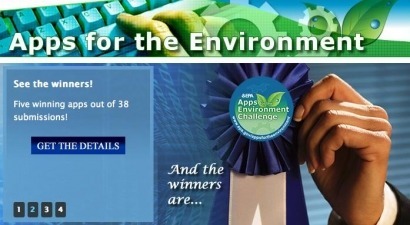
This past summer the U.S. Environmental Protection Agency (EPA) announced the Apps for the Environment Challenge: a contest to encourage “private sector software developers, students, and others to create innovative applications (‘apps’) that use EPA data to promote protection of human health and the environment.”
Apps are popular with smart phone users for a wide variety of uses, such as finding the nearest restaurant or searching local retailers for the best buy. Tens of thousands of apps have been developed, including about a half-million for the popular iPhone.
The contest was designed to address EPA Administrator Lisa Jackson's seven priorities for the future:
By the contest’s end, 38 apps had been submitted, including some displaying a remarkably high level of sophistication and usefulness to the consumer. Winning submissions will be available for download and use by the public at the Challenge web site for one year.
First place in the contest went to Light Bulb Finder, an app that allows users to weigh the benefits of switching from incandescent to energy-efficient light bulbs, based on the lighting needs of users and the financial and environmental impacts of their choices. Light Bulb Finder uses zip code data from an EPA database to calculate carbon dioxide emission reductions for each light bulb replaced, taking into account the mix of fossil fuel and nuclear power used to produce electricity for a given location. The developer claims that by using this app, U.S. homeowners can cut their annual electricity bills by over $120 and reduce climate change gases (carbon dioxide) by 617 kg (1,360 lbs).
Hootroot, the overall runner-up, allows users to map a route between two U.S. destinations and determine the greenest way to get there. For example, when I entered my starting location (Raleigh, North Carolina) and destination (Charlotte, North Carolina), I was given the following five transit options:
In this example, most Hootroot users are not going to spend nearly two days walking to Charlotte, perhaps towing their baggage behind, and riding a bicycle this distance is also beyond the ability of most travelers. Also, flying is probably out of the question, given the extra time needed to drive to the airport, clear security, and wait around for take-off. The comparison between driving and the bus/train option is a little more intriguing, especially if you are not in a hurry. (If you are thinking that a tank of gas is less expensive than the bus and train tickets, don’t forget to consider the costs of auto insurance, taxes, maintenance, and depreciation.)
The CGSearch app, winner of the Popular Choice award, allows users to compare EPA’s Air Quality Index, air pollution levels, and energy consumption of various U.S. cities with those of Atlanta.
The winning student entry was EarthFriend, an iPhone, iPod, and iPad application that provides interactive educational games as well as environmental facts and data from EPA’s own databases. The app addresses climate change and water, air, and land pollution, and a “What Can You Do?” category challenges users to take action in going green.
Apart from the contest, the EPA has developed the AIRNow app, which allows users to see real-time air quality data and forecasts for over 400 U.S. cities. The AIRNow app for the iPhone and Android phone can be downloaded for free from the EPA AirNow web site.
If you have experience with any apps that may be useful to the renewable energy community, or have ideas for a new app, let us know by leaving a message below!
[Photo: The Apps for the Environment image is a screen shot of the EPA’s public web page]

